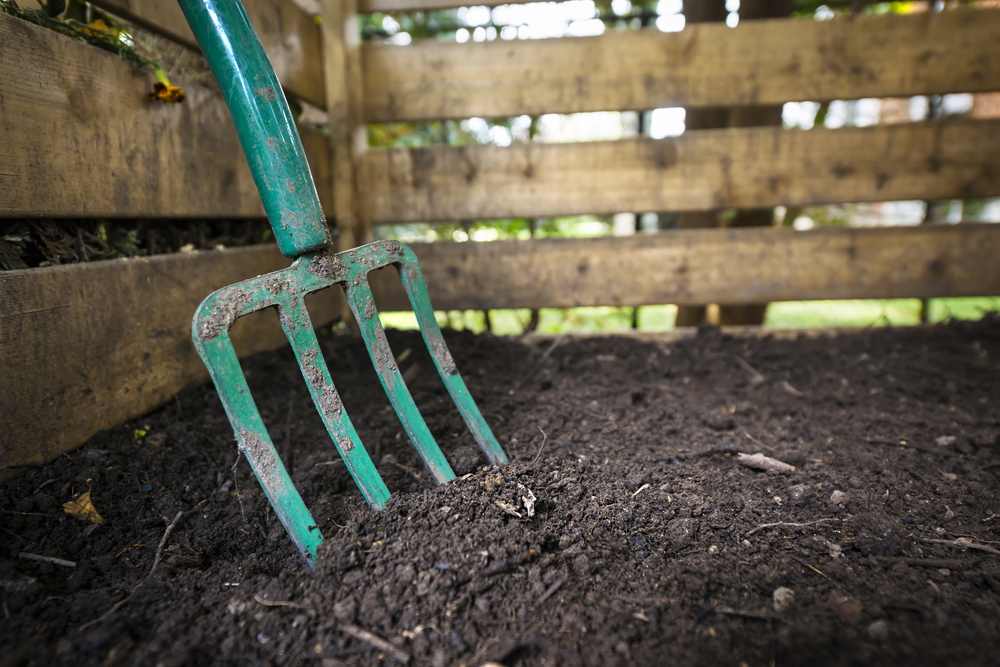Gardening is a great weekend activity for homeowners who want to keep their yards looking clean and attractive, and it is becoming a more popular hobby. Almost 50% of people in the U.S. have gardened in the past year. Gardening can improve your home’s value, contribute to landscaping designs and, depending on what you plant, it can save you money. Homeowners that spend just $70 on their vegetable garden can get $530 back in produce every season. Often times homeowners find it difficult to keep their landscaping costs down while maintaining a well-kept, good-looking garden. However, simply changing the type and source of soil used in gardening projects throughout the yard can cut costs and help plants grow. But how?
What is Organic Compost?
Simply put, compost is decomposed organic material, but it makes a great alternative to store-bought soil. Homeowners can create their very own compost pile in their backyard by disposing of food scraps, leaves and twigs in an organized manner. Organic composting containers can be purchased at a store that sells gardening and landscaping supplies, or they can be made at home. Once the container is set up in the back yard, a mixture of organic material can be continually added and turned to create the perfect organic compost for all of your gardening needs.
Why Compost?
Composting has a number of benefits for gardeners. First of all, it makes the perfect soil to plant flowers and vegetables in. Organic compost is high in nutrients, and when mixed with other soil, it increases the nutrient content and helps retain moisture, which is essential to growing healthy plants. Using compost for gardening can help plants grow to their full potential. Composting also saves gardeners money. The cost of store-bought soil can add up after a while, whereas growing your own soil is free. Last but not least, composting is good for the environment. Repurposing materials reduces the amount of pollution in landfills, and it has also been shown to prevent erosion.
More and more people in the U.S. are picking up gardening, with many starting to grow their own vegetables. There was a nearly 20% increase in home vegetable gardens between 2008 and 2009, and this number is growing. Compost is one of the best ways to help these vegetable gardens and other plants grow strong and healthy.
Topsoil v. Compost: What’s the Difference?
Have you ever wondered what the difference is between topsoil and compost and what is best for your project? We thought it might be a good time to talk about the difference so you can decide what you need.
Topsoil is the first layer of ground in your landscape. However, topsoil is also a product you can purchase. It is a mixture of mineral grains, organic matter, water and air. That mixture is designed to provide nutrients to plants and help hold water so you don’t have areas of erosion in your landscape.
Compost is made of decaying plant and animal matter, so it is organic matter. It doesn’t have the same mixture as topsoil, so it has a different function. Compost is designed to provide nutrients to the topsoil and all the layers of soil in your landscape.
Every landscape can use an infusion of good topsoil and compost. We recommend you contact us for help on how much you need. Then after both the topsoil and compost are delivered, it’s an easy process. Put a mixture of topsoil and compost in garden beds and rake the mixture into the existing soil. Then add a layer of mulch.
For your lawn, sprinkle a coating of the mixture and then water it. You can even mix grass seeds with this and overseed your lawn at the same time.
The fall and winter moisture will distribute the nutrients to plant roots and throughout the soil layers. Then in the spring and summer you will see the results of plants having that food they need.
Mulch v. Compost: Which is Best?
Compost and mulch are both useful in gardening, and can be used to solve a number of landscaping issues. Many people think compost and mulch are basically the same thing, but there are a few differences worth noting. Here are some things you need to know that will help you choose the right product for the job.
Mulch is material that is spread over the soil in order to conserve water, control weeds and protect plants from extreme temperature changes. On the other hand, compost is typically added to the soil to help enrich it and provide essential nutrients.
Compost is derived from organic items such as vegetable peelings, egg shells or shredded leaves. Mulch can be made from organic materials such as wood chips or straw, or inorganic materials like shredded rubber or plastic. Some of the same materials used for mulching can also be used to make compost, with the primary difference being that particles are normally shredded very finely when added to compost, and remain much larger when used as mulch.
Compost can be used in place of mulch; however, because it contains smaller particles, it will decompose faster and need to be replaced more often. It is also less effective at keeping weeds at bay than mulch is. Plants are unable to absorb many of the nutrients from compost when it is placed on top of the soil rather than being added to it, which means your garden won’t benefit as much from using it in this manner.
Successful gardeners recommend using compost in the soil and mulch on top so that plants can reap the benefits of both materials. Here at Saunders Landscaping Supply, we deliver both mulch and compost free of charge to our customers. To find out how to get mulch delivered free in northern Virginia, contact us.

